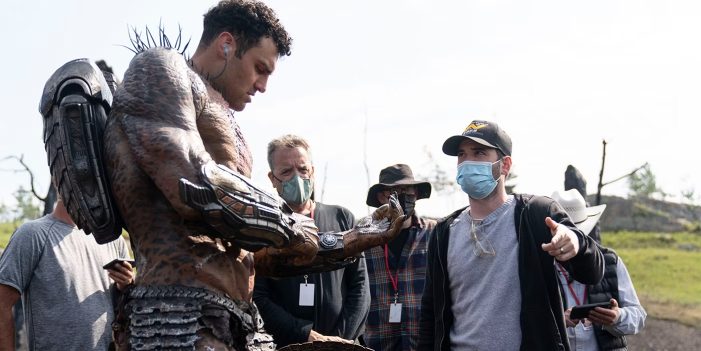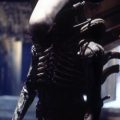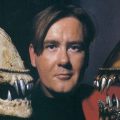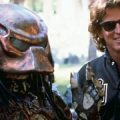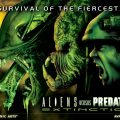Tom Woodruff Interview (2)
Posted by Darkness on December 2, 2022 (Updated: 22-Aug-2023)
Tom Woodruff is the co-founder of special effects studio, Amalgamated Dynamics Inc, along with Alec Gillis. They worked on Aliens under Stan Winston before forming they’re own studio. They’ve worked on many films since then including handling the effects on Alien 3, Alien Resurrection, AvP, AvP Requiem, The Predator and Prey. It was recently announced that Gillis and Woodruff were parting ways, with Alec Gillis starting his own special effects company Studio Gillis.
We originally did an interview with both of them back in December 2006, Next, RidgeTop visited the StudioADI workshop in December 2017 and produced a report and video interview with both of them. We interviewed them in April 2021 and Tom Woodruff in November 2021 about being inside the Alien costume. RidgeTop and Corporal Hicks have now interviewed Tom Woodruff for Episode #156 of the AvPGalaxy Podcast and the interview is focussed on the special effects in the recent Prey film. You can watch the episode below or continue on for a transcription of the most important parts.
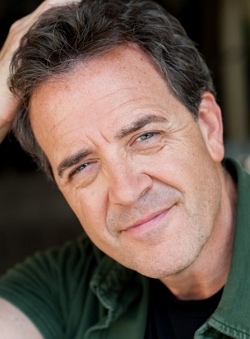
Tom Woodruff
Adam: Thanks again for joining us today, Tom. So, a year ago we spoke with you about your history of performance in this franchise. Of your time in the alien suit. Today we’d like to focus more on the Predator side of things, namely your time on Prey. So, can you tell us how this project came about for StudioADI? We understand you were originally approached to just build the suits, but it expanded into the creative process too taking over those duties from Aaron Sims company and how is it distinct from what you had done with the Predator franchise before?
Tom: Well, we’ve had a long period of creative time spent with the Predator series and that’s if you include or do not include my work on the original Predator when I was still at Stan’s. It was very small. I think I was just doing finger extensions with claws for Kevin Peter Hall to wear as the Predator and that was the last, I had seen of it until the AvP movies came up and at that point, it was very exciting to take on both of those franchises. The alien franchise, we picked up with Alien 3 and Alien Resurrection but then to add the Predator to it, those were some pretty high and mighty days because we had big shoes to fill.
We wanted to put our sensibilities, our own personal sense of art and design material into them and for the most part the fans, I think the fans preferred the first AvP surprisingly after early reports when they found out it was an R-rated movie. It was not going to be an R-rated movie but PG-13. I think a lot of them were ready to jump ship or it did jump ship, but I think they came around and then AvPR and then The Predator with a much smaller cast. We had the key Predator and then a couple of other Predator like sentries that were also involved. That was the one Shane Black did and then most recently now Prey with Dan Trachtenberg.
Aaron: So, it was originally just to do the suits right for Dan for Prey?
Tom: We start the process with the designs for the Predator obviously and I think it happened so fast where we went back to him and said “In the past we’ve done the weapons as well.” He thought it over and passed that part on to us as well because in previous films we had always done the Predator and the Predator’s armor and the Predator’s weapon and because there’s so much interaction with the sculpted Predator body and the sculpted armor and weapons and everything that have to plug into it. It makes so much more sense from a design and a construction point of view to have it all coming out of one group.
The best communication can still get messed up. Even when we’re in the shop, there can be some misses but it’s so much more ready to be a success if we can all be together on it. So, I don’t remember it being a long time and the Aaron Sims material… this happens a lot and I’m not slanting it in any kind of a negative way. Aaron Sims is brilliant designer, and he always has a great team of artists working for him. A lot of times when productions are gearing up one of the first things they’ll do, is they’ll want a designer.
Sometimes it could be so early that they want designs so they can go back to the studios or back to whoever’s funding the film and go “Look at all this great art. Imagine how great this going to be in a movie” and Aaron is usually approached during that phase as well as into early production more than we had ever been. Some of the earlier smaller movies we would design. We would create. We’d go to set but some of the bigger movies… I think the big filmmakers and the big studios have always for a long time have gone to Aaron to get designs turned out.
Aaron: So, it’s kind of more like Patrick Tatopoulos’s pre-AvP artwork for Anderson’s pitch? More like that kind of thing than stuff to create your constructive process?
Tom: From my point of view, I’ve not been in on that process with Aaron. I’ve only seen him a couple of times over the years and never really discussed or understood his exact process but even on the X-Men movies and like quite a few movies. A recent movie I bid on that didn’t even happen that went away… they had some beautiful Aaron Sims designs and they’re very complete. There’s a great show quality to them, to the actual artwork than to our designs which are sometimes rough but sometimes if we have time, we’ll pull in some artists to either do flat artwork or 3D some sculptures.
Aaron: So, we’ll get this one out of the way early as well. So, it’s something that is on a lot of fans’ mind, especially after the recent social media announcement that you and Alec were parting ways and heading in different directions creatively now. So StudioADI is ending. Alec has got his own thing with Studio Gillis so where do you see yourself heading with your creative processes going forward?
Tom: Yeah, well surprisingly when I was a kid and I moved out to California, it was dream come true and it was the best things, and it was the worst things and it all mixed up and it was always great. It was always exciting and very pleasing to finally get into that the whole genre not just of monsters and creatures but character effects, makeups and special things like that and it got to the point where I had always wanted to come back here. I’m living in in the state of Pennsylvania right now and I’m with close access to Philadelphia and New York.
I’m about three and a half hours away which actually worked out well for the movie Smile which was shot in New Jersey. I jumped in my car and drove two and a half hours and I was on the set. So, there was something about that kind of… I had just gotten tired of traveling. I’ve gotten tired of traveling to different locations in different countries and in an effort to chase those tax credits that make these movies possible at the level they’re being produced. I always wanted to come back here but come back here, not as an old man just sitting down and reflecting on the movies I’ve done but still being very active in both sculpting and painting and really design work just to make me happy. Make me feel creatively fulfilled but I’m still trying to keep that kind of contained because I’m spending more of my time now developing projects whether it’s scripts or pitches and I’ve done a lot of phone pitches.
Ever since Covid I haven’t been in anybody’s office since then. Now that I’m back here if it happens, I would have to travel but phone pitches with people that I know that are well established have always yielded some kind of positive response. I’ve gotten some great concepts across to people that obviously get it. They don’t get it enough yet to give me a budget and start making a movie or even a streaming series, but I have all those options. It’s actually been a great delight to be able to have the time to… I come into my office early in the morning.
I work through lunch. I do a couple things after lunch and then I’ll do another hour or two depending on where I’m at mentally with something and if not, I go out in my garage and I sculpt or I paint. It’s been a really great balance of the creativity that I want to continue to trust. I’ve looked forward to it for a long time, so the decision was not hard to make. It was just the timing of the decision.
Adam: Something that’s always been a hot topic in the world of those passionate about practical effects like us is the blending of practical and digital effects. Prey has a lot of great practical effects on display but there are some notable digital additions over the suit and a few full body shots of a CGI Predator in this. How do you personally feel about the balance of the different types of effects in Prey?
Tom: Well I think there’s an aspect to it all now where digital effects, there’s a lot of stunning digital effects work happening now. The Planet of the Apes movies after I think probably into the third one. Between the third and fourth one, it started to become flawless and watching something to a character to that kind of design that obviously isn’t makeup, and it obviously isn’t a man in a suit.
To me it was very successful on screen to see those characters and the concept of bringing that into a film that’s already defined as a practical effects approach film, it certainly helps. It’s like there’s these little details that help make the Predator seem real without going completely digital. Then there’s certain stunts and effects where without a digital Predator that looks good which this one did. Without a digital Predator there’s certain scenes especially pieces of action would have to be cut back or cut all together. I’m all for a combination of approaches.
Aaron: And from your perspective being the practical guy on this film, you sort of mentioned it when we spoke last. That supervisor coming and introduced himself as being the laziest VFX team that you’d ever meet. Were you sort of happy then with that balance in this film?
Tom: No honestly, I didn’t. There was a couple of things that have been talked about is there’s a scene with a shot where a Predator roars. We’ve sculpted a lot of weird hanging stuff in his mouth and digitally they made it sort of move and vibrate at a high frequency. Could we have done that? We could have done something like that if the director had come to us and said “Hey I want to do this close-up at the end of the week. I want to see everything happening.”
We’d be sticking tubes in it or wires or something to make it make it happen, but it would not have been as direct or as directable as what Dan was able to do with a post VFX addition and then there’s also the Predator hand right with the ash and just seeing him move his hand like that. I don’t think most people look at that and say, “Oh that’s a digital effect.” Even though it was but what it was when it’s something that’s close, you didn’t see a Predator’s hand. You wouldn’t see the wrinkles in the glove right.
You wouldn’t see little cracks from the latex, and it was also about the joints. I mean we can extend a Predator’s fingertip up to here and make it that long if we want to but the problem is that nothing up here is going to bend unless it’s slaved to a movement down here. Once you have to add wires and mechanisms to do that, you start to kind of impinge on the design. The sleek long fingers of the Predator. So again, I think that was a very useful visual piece to help keep the audience guessing.
Adam: Yeah we had just noticed that MPC just recently released a show reel showing like all the digital effects they had done for the film and that one. It was hard to tell at first if like the hand was CG. So that one was pretty well done I thought but they showed like the practical hand that you had built there and their replacement of that in their show reel.
Aaron: It’s funny you say that because I kind of feel like that was one of the moments that a lot of people pointed out. It looked different to what we’ve seen of the practical hands earlier.
Adam: Oh, that’s right when he has like the medical kit because there’s kind of a close-up on his hand there when he’s healing himself too I think but that one is practical.
Tom: It’s funny to have run this whole route for me and for ADI basically but for Stan Winston starting with Aliens and just the world opens up on Stan Winston Studios a little bit more than just Predator and some of his earlier films. He had a handful of great hits but on Aliens when there was no digital option for example right, there was so little detailing from the fans of “Did this rubber glove work and did this suit work?”
And the truth is I think Starlog put out an Aliens magazine before the movie had opened up and right on the cover is a picture of one of the cast members wearing the… I think she’s in the dropship right and there’s an alien hand coming around her and it was just one of the rubber background hands we had made. There was nothing. There was no expertise. There was no foam that you could do this, and it had this big dent in it like this and I remember looking at it thinking “Oh my God. It looks like we don’t know what we’re doing and what are people going to think of this?”
We didn’t hear anything about it then as opposed to today where the fans are so savvy, and they’re so invested in this long franchise. I think they’ve got a sense of ownership and they don’t want to be tricked. Right, they don’t want to be tricked into having a digital effect but anything to me is better than the way I felt when I saw that that thick rubber hand on Starlog magazine.
The fans are over analytical because they can afford to be now. In terms of access to entertainment before DVD before VHS you go in and see it and you go back and see it. I remember when Star Wars came out and I was at a great age to see Star Wars. I was 18 years old and didn’t know what I was walking into. There’s no way to study frames from Star Wars so I would just go back and I think I saw the movie nine times in theater and it always caught me in the story more like I’d sort of stopped… like to me the that that whole cantina band scene. I thought as an 18-year-old kid starving for monster entertainment, I love that.
I loved everything about it. Rick Baker didn’t know what Star Wars was when he did some work on it. He just knew it was some science fiction outer space movie and what a great surprise but back then compared to now when you can get the Blu-ray and you can download it. You can stop on single frames, the fans do have that access to fully involve themselves in what happened on screen.

